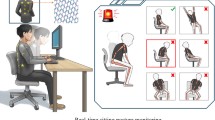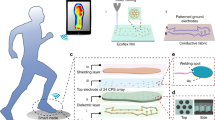Abstract
Everyday millions of people perform office work with long sitting in front of computers. This results in a poor posture in the spinal which is normally called Kyphosis. This problem becomes significant when the upper back of the spine crosses the angle of 5 degrees. Among the types of poor postures, there is one as slouching. Slouching for a longer duration of time with more frequency may result in spine bends on the upper region and becomes noticeable in the personality, especially during walking and sitting on the couch. When the spine angle in the upper back region reaches 50°, it starts giving pain to the patient which leads to spine surgery. Commonly orthopedics recommends spinal fusion surgery at this angle. Therefore, this article presents a novel design of a device with an automatic system for avoiding the slouch and retracting the angle of the spine for a good posture. In this device, there is a novel skeleton system, shoulder pads, a controller unit, and a McKibben actuator-based forcing mechanism. The complete system of this device is manufactured in a 3D printer using FDM technology. Pressurized water is pumped into the McKibben actuators in control conditions for generating the back force to retract the spine angle as well as to position the shoulders for avoiding the slouch. With the change in the angle of posture gives a shift in the values of water pressure. That results in the generation of back force in the actuators for correcting the posture. The skeleton is tested on people with a posture problem in the range of 20° to 45°. Results show that the pressure variation from 160 to 190 kPa in the water triggers the signal to generate a force between 19 and 34 N that is decreasing the posture angle up to 25°. The force produced by McKibben actuators is evaluated theoretically as well as experimentally, and the plots give harmonious behavior as well. The experiments illustrate that the proposed skeleton produces a nominal backward force to correct the posture automatically.



















Similar content being viewed by others
Data availability
Data and material can be provided upon request.
Code availability
Not applicable.
References
Ussery EN, Fulton JE, Galuska DA, Katzmarzyk PT, Carlson SA (2018) Joint prevalence of sitting time and leisure-time physical activity among US adults, 2015–2016. JAMA 320(19):2036–2038
Zappalá M, Lightbourne S, Heneghan NR (2021) The relationship between thoracic kyphosis and age, and normative values across age groups: a systematic review of healthy adults. J Orthop Surg Res 16(1):1–18
Maidin NA, Ab Rahman MH, Ahmad MN, Osman MH, Wahid MK, Firdaus MS, … Afiq Razali MZ (2018) A prototype development of anti-hunchback device. J Mech Eng 15(1):192–209
Asadullah GM, Ali M, Hashikura K, Kamal MAS, Yamada K (2022) Development of an automatic air-driven 3D-printed spinal posture corrector. In Actuators (Vol. 11, No. 7, p 184). Multidisciplinary Digital Publishing Institute
Sangian D, Naficy S, Spinks GM, Tondu B (2015) The effect of geometry and material properties on the performance of a small hydraulic McKibben muscle system. Sensors Actuators, A 234:150–157
Zhang N, Mohd Faudzi AA (2021) Finite element analysis (FEA) deformation model of McKibben actuator using Simscape Multibody in MATLAB. In RiTA 2020. Springer, Singapore, pp 273–283
Mastropoll CA, Herchenroder KM, Luna MMP, Betancur ST (2018) Dynamic correction of postural kyphosis.
Li X, Xiao Z, Yang K (2020) The design of seat for sitting posture correction based on ergonomics. In 2020 International Conference on Computer Engineering and Application (ICCEA). IEEE, pp 703–706
Lee SM, Kim HJ, Ham SJ, Kim S (2021) Assistive devices to help correct sitting-posture based on posture analysis results. JOIV Int J Inf Visualization 5(3):340–346
Flutur G, Movileanu B, Károly L, Danci I, Cosovanu D, Stan OP (2019) Smart chair system for posture correction. In 2019 22nd Euromicro Conference on Digital System Design (DSD). IEEE, pp 436–441
Ray R, Nouaille L, Colobert B, Calistri L, Poisson G (2021) Design of a robotic brace with parallel structure for spine deformities correction. In IFToMM Symposium on Mechanism Design for Robotics. Springer, Cham, pp 159–167
Kumar A, Aravindan MC (2017) Posturector-the posture corrector. Int J Innov Sci Res Technol 2:70–74
Hassan M, Kennard M, Yagi K, Kadone H, Mochiyama H, Suzuki K (2019) MRLift: a semi-active lower back support exoskeleton based on MR fluid and force retention technology. In 2019 IEEE/RSJ International Conference on Intelligent Robots and Systems (IROS). IEEE, pp 7349–7354
Redaelli DF, Abbate V, Storm FA, Ronca A, Sorrentino A, De Capitani C, … Fraschini P (2020) 3D printing orthopedic scoliosis braces: a test comparing FDM with thermoforming. Int J Adv Manuf Technol 111(5):1707–1720
Zhang J, Zhang H, Dong C, Huang F, Liu Q, Song A (2019) Architecture and design of a wearable robotic system for body posture monitoring, correction, and rehabilitation assist. Int J Soc Robot 11(3):423–436
Chae DS, Kim DH, Kang KY, Kim DY, Park SW, Park SJ, Kim JH (2020) The functional effect of 3D-printing individualized orthosis for patients with peripheral nerve injuries: Three case reports. Medicine 99(16)
Kumar M, Gurram HPR, Srikar PL (2022) A portable posture monitoring device for gymgoers. ECS Trans 107(1):14869
Pratheep VG, Priyanka EB, Thangavel S, Heenalisha K, Ariya Manickam M, Logaram AP (2021) Automatic body posture corrector for spinal cord patients. In Materials, design, and manufacturing for sustainable environment. Springer, Singapore, pp 195–205
Bramhapurikar K, Prabhune A, Chavan S, Ghivela GC, Sengupta J (2018) A wearable posture corrector device. In 2018 9th International Conference on Computing, Communication and Networking Technologies (ICCCNT). IEEE, pp 1–5
Severin IC (2020) Head posture monitor based on 3 IMU sensors: consideration toward Healthcare application. In 2020 International Conference on e-Health and Bioengineering (EHB). IEEE, pp 1–4
Sabyrov N, Sotsial Z, Abilgaziyev A, Adair D, Ali MH (2021) Design of a flexible neck orthosis on fused deposition modeling printer for rehabilitation on regular usage. Procedia Comput Sci 179:63–71
Shin JG, Onchi E, Reyes MJ, Song J, Lee U, Lee SH, Saakes D (2019) Slow robots for unobtrusive posture correction. In Proceedings of the 2019 CHI Conference on Human Factors in Computing Systems, pp 1–10
Sardini E, Serpelloni M, Pasqui V (2014) Wireless wearable T-shirt for posture monitoring during rehabilitation exercises. IEEE Trans Instrum Meas 64(2):439–448
Lou E, Lam GC, Hill DL, Wong MS (2012) Development of a smart garment to reduce kyphosis during daily living. Med Biol Eng Compu 50(11):1147–1154
Moustafa IM, Shousha TM, Walton LM, Raigangar V, Harrison DE (2022) Reduction of thoracic hyper-kyphosis improves short and long term outcomes in patients with chronic nonspecific neck pain: a randomized controlled trial. J Clin Med 11(20):6028
Busscher I, Ploegmakers JJ, Verkerke GJ, Veldhuizen AG (2010) Comparative anatomical dimensions of the complete human and porcine spine. Eur Spine J 19(7):1104–1114
Acknowledgements
The experiments are carried out at the research facilities under the Department of Mechanical and Aerospace Engineering, School of Engineering and Digital Sciences, Nazarbayev University, 010000 Astana, Kazakhstan.
Funding
This research is jointly funded by the Ministry of Education and Science (MES), Republic of Kazakhstan, Grant No. SEDS2022014, the source of funding code is 055.01.01 and, by Nazarvayev University under the Faculty Development Competitive Research Grant Program (FCDRGP) Grant No. 021220FD1551.
Author information
Authors and Affiliations
Contributions
Malik K. I., Kemel S., Darkhan O., and MH Ali generated the idea, created a methodology, wrote the original draft, and finalized the article. E. Shehab has supervised the research and reviewed the manuscript. MH Ali has obtained the grant, supervised the research, and discussed progress with students, regularly.
Corresponding author
Ethics declarations
Ethics approval
Not applicable.
Consent to participate
Not applicable.
Consent for publication
Not applicable.
Conflict of interest
The authors declare no competing interests.
Additional information
Publisher's note
Springer Nature remains neutral with regard to jurisdictional claims in published maps and institutional affiliations.
Rights and permissions
Springer Nature or its licensor (e.g. a society or other partner) holds exclusive rights to this article under a publishing agreement with the author(s) or other rightsholder(s); author self-archiving of the accepted manuscript version of this article is solely governed by the terms of such publishing agreement and applicable law.
About this article
Cite this article
Ijaz, M.K., Shomenov, K., Otegen, D. et al. Design and development of a 3D printed water driven spinal posture corrector. Int J Adv Manuf Technol 124, 1457–1471 (2023). https://doi.org/10.1007/s00170-022-10611-7
Received:
Accepted:
Published:
Issue Date:
DOI: https://doi.org/10.1007/s00170-022-10611-7




